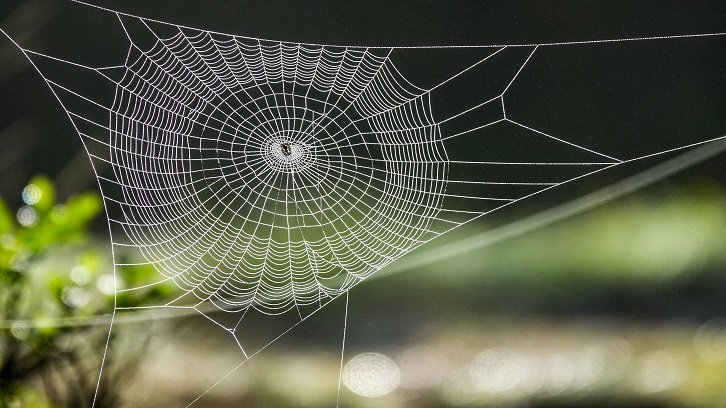The architecture of the spider web

The spider web is one of the most resistant materials in nature, distinguishing different types according to the gland of secretion and the protein composition. A collaboration between the UAB, the CNIC and the CTB has carried out a study to determine the different protein compositions of each fabric, providing new advances in their synthetic production with biotechnological applications of interest.
The spider web is one of the most iconic characteristics from these animals. The spider silk is one of the toughest materials in nature, being its fibers tougher than Kevlar, the material from which the bulletproof vests are made and five times tougher than steal. Despite what it may seem, not all spider silk fibers have the same composition neither they are secreted by the same type of spider gland. In total there are seven different silk-producing glands, the major ampullate, minor ampullate, flagelliform, tubuliform, piriform, aciniform and aggregate glands.
The silk produced from each of these glands has a different protein composition, bestowing it different physical properties. For instance, the major ampullate gland produces the type of fiber that constitutes the main structural elements of the web or the lifeline that the spider uses while weaving the web. The minor ampullate gland produces a special silk for accessory spirals in the web, the flagelliform gland is used to build intermediate viscous sticky threads in the web to catch prey, the tubuliform gland produces silk to wrap the egg sac or the aciniform gland which produces the fibers used to wrap the prey that has been caught.
Figure 1. Different uses of the various types of silk depending on the secreting gland. Each of the glands secretes a silk with a specific protein composition, bestowing differential physico-chemical properties making the structure of the fiber the most suitable for each of its functions.
In the referenced work mentioned in this article, we have studied different proteins from spider silk (MaSp1, MaSp2, MiSp, Flag y TuSp) and have observed that the silk produced by each gland is the result of a mix of these proteins at different proportions, as reported in the table below. Each of these proteins has a very specific aminoacidic sequence and provides different elasticity, toughness, flexibility and adhesive properties to the fiber. For instance, the fiber produced by the flagelliform gland is highly sticky and as observed, is the only studied gland that produces fibers containing Flag protein. Likewise, TuSp protein is only produced by the tubuliform gland, where it represents its main component. Interestingly, none of these glands produce MaSp2 protein.
Figure 2. Figure 2. Percentages of protein relative to the silk secretion gland.
The acquired knowledge regarding protein composition of each of the different spider silks is highly valuable to study potential synthetic production of different substances mimicking these biomaterials or to accurately produce a new material closer to the original one. The further research in this field could pave the way for the design of future high-performance biomaterials.
Cell and Bioprocess Engineering Group (GECIB), Department of Chemical, Biological and Environmental Engineering
Universitat Autònoma de Barcelona
References
Jorge I, Ruiz V, Lavado-García J, Vázquez J, Hayashi C, Rojo FJ, Atienza JM, Elices M, Guinea GV, Pérez-Rigueiro J. Expression of spidroin proteins in the silk glands of golden orb-weaver spiders. J Exp Zool B Mol Dev Evol. 1–13 (2022). DOI:10.1002/jez.b.23117


